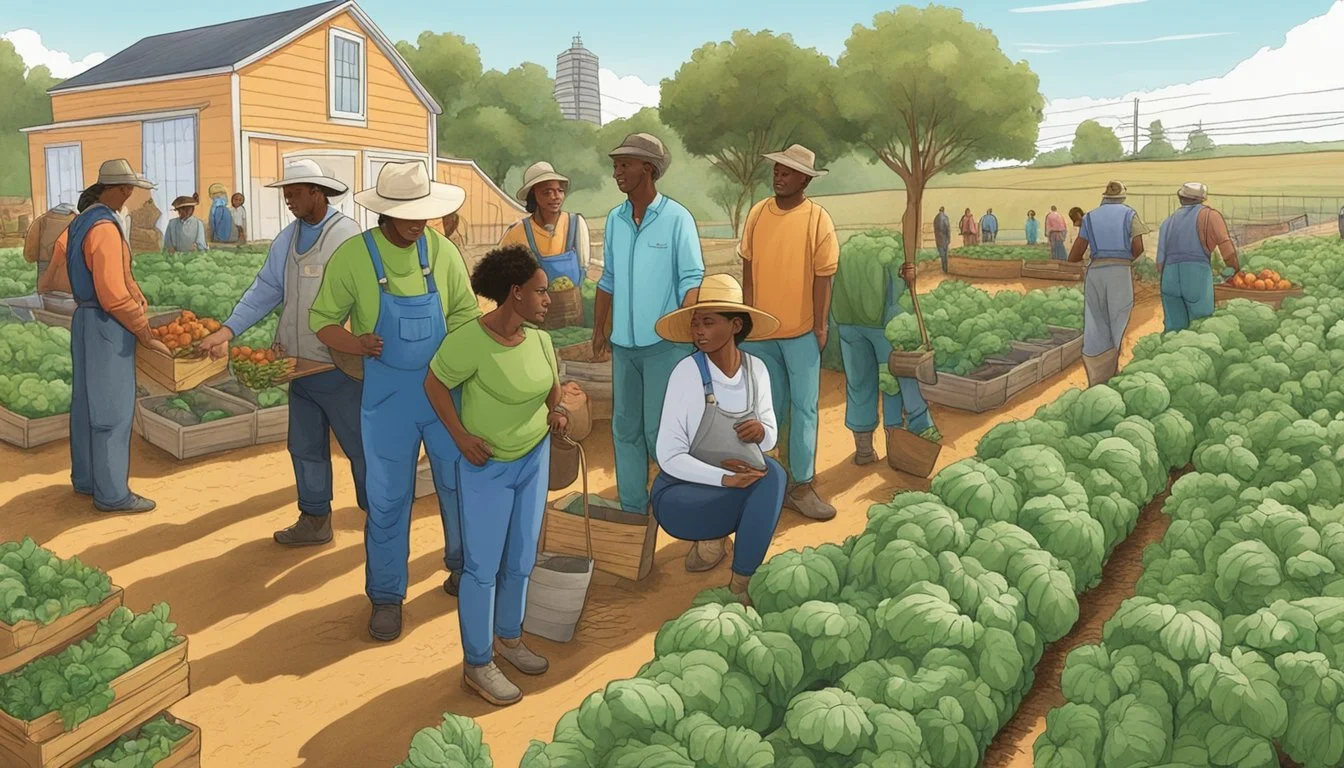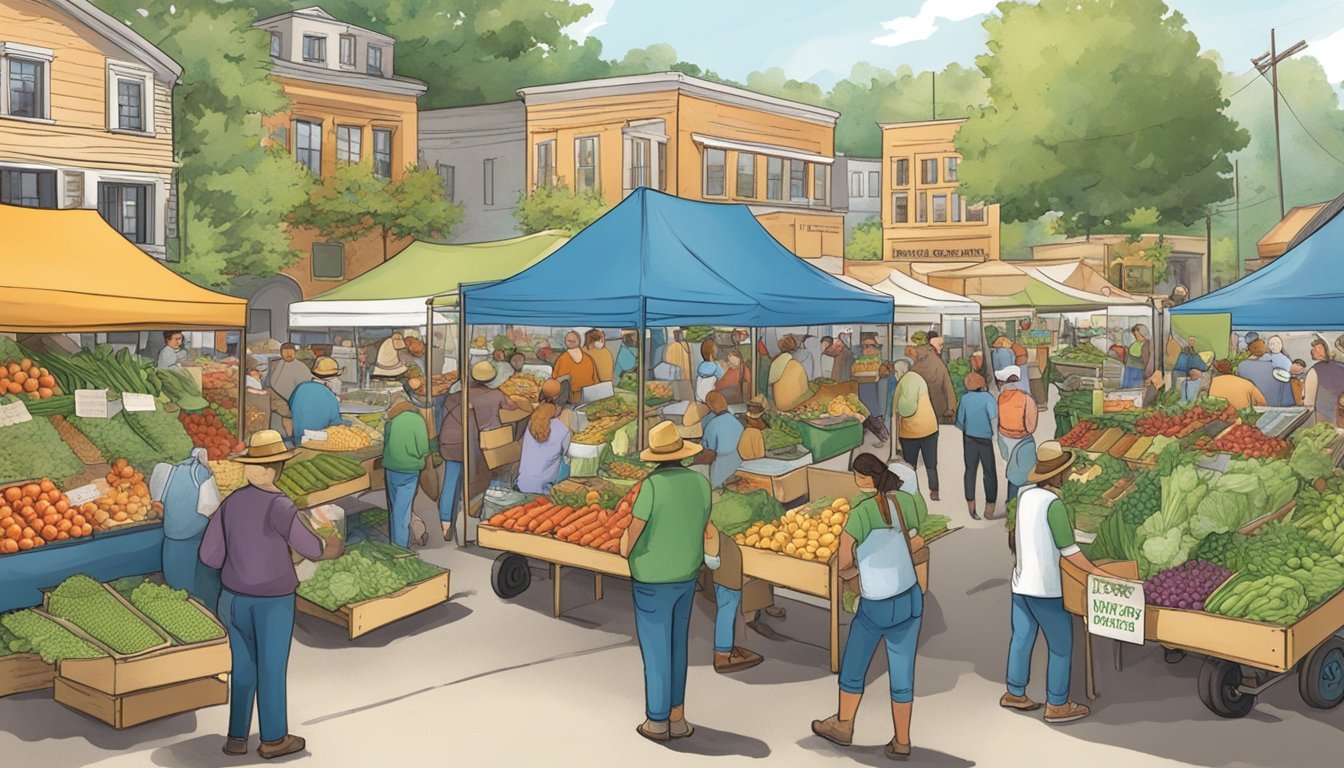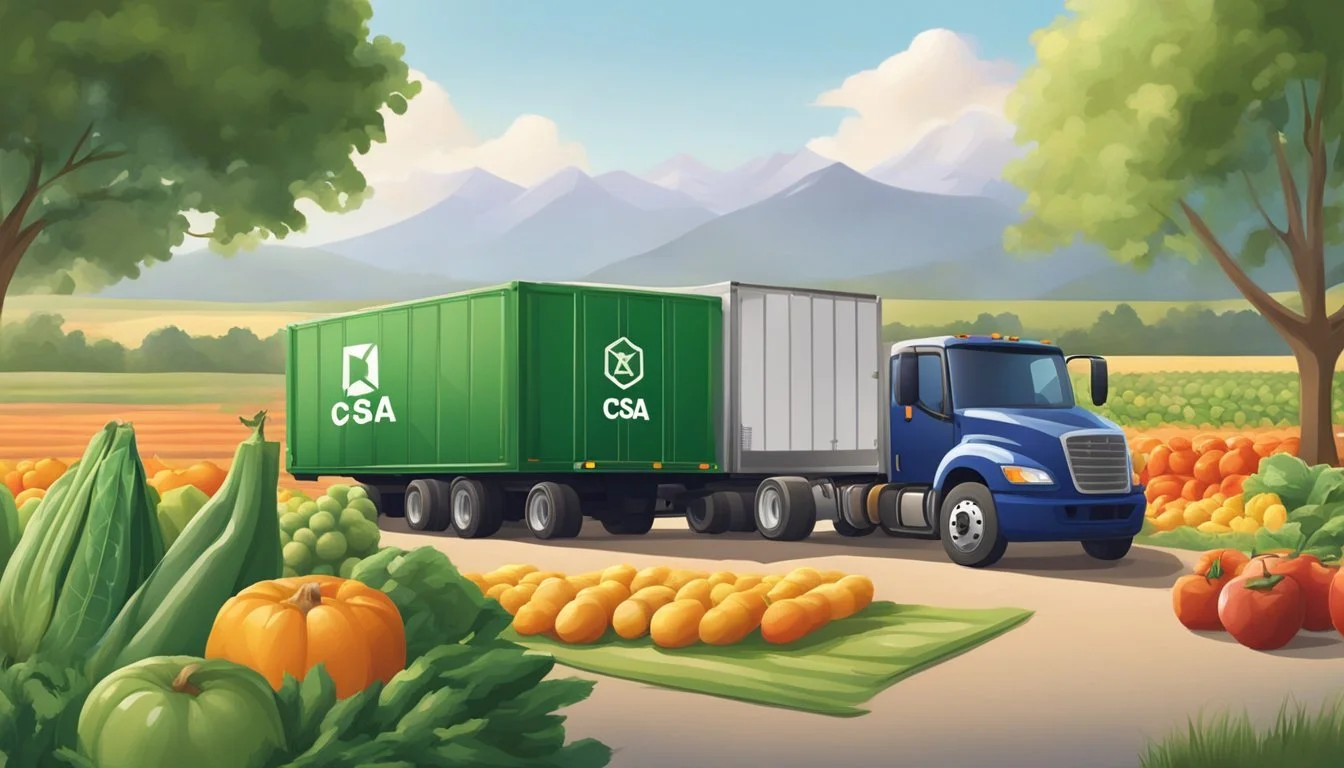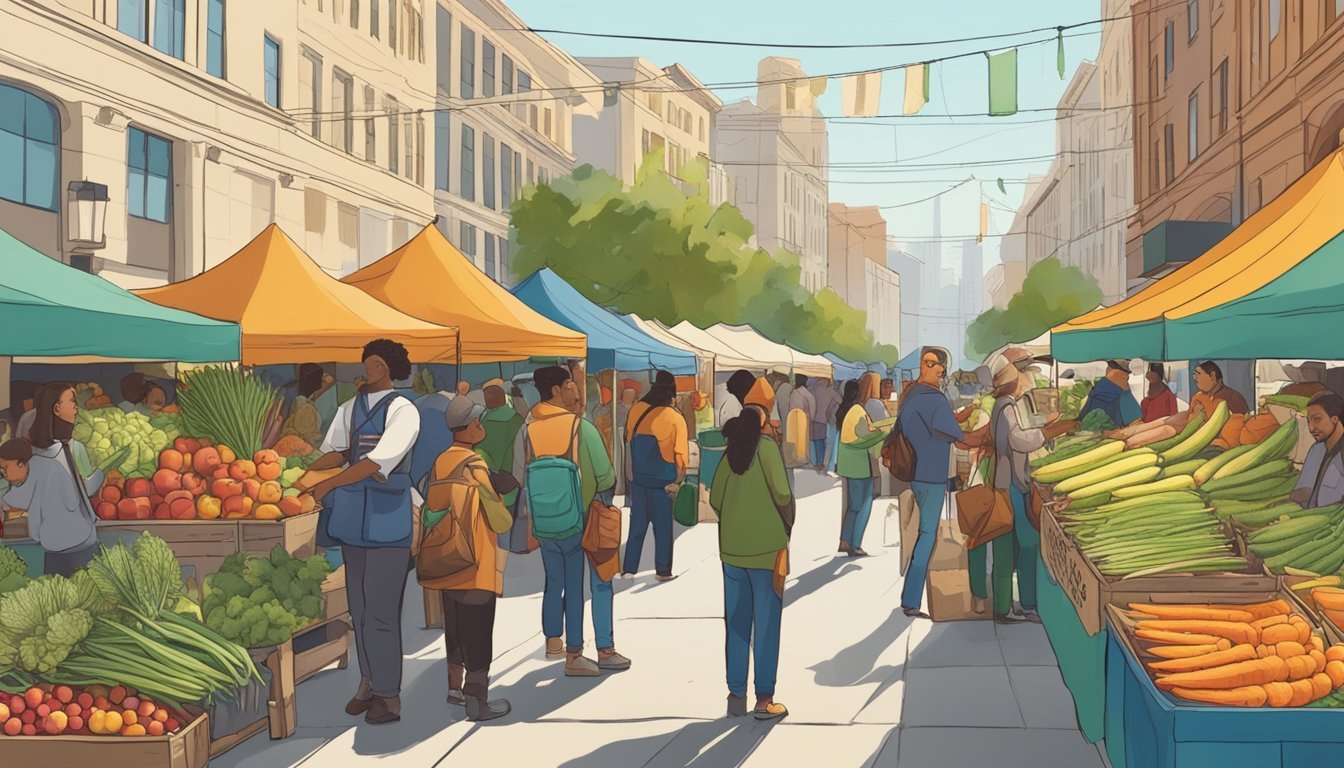Community Supported Agriculture (CSA) in San Francisco, CA
A Guide to Local, Sustainable Food Choices
Community Supported Agriculture, commonly known as CSA, has become a significant part of San Francisco's local food ecosystem. A CSA program establishes a partnership between local farmers and consumers in the Bay Area, where the consumer purchases a 'share' of the farm's production prior to the growing season. In return, they receive regular distributions of the farm's yield, usually in the form of a box of assorted fresh fruits and vegetables. This model supports farmers by providing them with upfront funds for their seasonal costs and guarantees them a stable market for their produce.
CSA in San Francisco taps into the city’s appreciation for sustainable agriculture and fresh, organic produce. Many CSA farms deliver directly to drop sites throughout the city or even to the consumer's doorstep, making it a convenient option for residents who are health-conscious and environmentally aware. Offering everything from heirloom vegetables to pasture-raised eggs, CSAs are also educating the community on the importance of seasonal eating and the benefits of supporting local food systems.
The promise of fresh, organic produce coupled with the direct relationship forged between growers and consumers is at the heart of CSA's growing popularity in urban settings like San Francisco. This model not only fosters a sense of community around food production but also acts as a catalyst for a more sustainable and equitable food system. San Franciscans have access to a variety of CSA options, ensuring that there are ample opportunities to support local farms while enjoying some of the best seasonal produce the Bay Area has to offer.
The Concept of CSA
Community Supported Agriculture, or CSA, represents a partnership between local farmers and community members who seek fresh, locally-grown produce. Its foundation is built on trust and direct interaction, as members pay for a share of the harvest upfront, providing capital for the farmers at the start of the growing season.
History of CSA
The CSA model is rooted in a shared desire to foster sustainable agriculture and bolster community engagement with local food production. Originating in Japan in the 1960s, it emerged in the United States in Massachusetts during the 1980s. It reflects consumers' values concerning environmental stewardship and a preference for organic, seasonal food. Through CSA, agriculture becomes closely linked with the rhythms of the seasons and the health of the land.
CSA Business Model
The CSA business model is a subscription-based service. Members pay in advance for a 'share' of the upcoming harvest. This payment structure secures a regular source of income for farmers, allowing them to plan and manage their farm operations effectively. In turn, members receive fresh, seasonally appropriate produce, typically on a weekly basis, and become intimately connected with the cycle of food production. This model fosters a sense of community and trust, as both farmers and members share the risks and benefits of food production.
Membership: A commitment from customers, typically fulfilled through advance payment for a season.
Payment: Members usually pay upfront for a season's worth of produce, which can vary in quantity and type.
Subscription: A seasonal or annual membership granting the member a share of the farm's yield.
Trust: Inherent in the CSA model is a level of trust between grower and consumer.
Partnership: A cooperative relationship between the member and the farm.
Agriculture: The focus on organic, sustainable farming practices.
Community: Members often become part of a farm's community events and volunteer opportunities.
Seasonal: Produce provided is seasonal, reflecting local growing conditions and crop availability.
Benefits of Joining a CSA
Joining a CSA in San Francisco offers tangible perks, from accessing the freshest organic produce to bolstering eco-positive farming. It's a commitment embracing both health and community support.
Fresh and Organic Produce
Members of a CSA enjoy a consistent supply of seasonal produce that's often harvested at its peak of ripeness. This direct pipeline from farm to table not only ensures maximum freshness but also promotes organic farming methods that shun harmful pesticides and chemicals, safeguarding consumers' health.
Support for Local Farmers
By participating in a CSA, consumers directly contribute to the livelihood of local farmers. This support provides farmers with vital upfront capital, helps to mitigate the risks of farming, and fosters a close-knit community built around sustainable agriculture, contributing to food security and local economies.
Environmental Advantages
Embracing a CSA means championing sustainable energy practices. Farmland surrounding San Francisco that operates under CSA models is more likely to employ eco-positive strategies, like crop rotation and reduced transport distances, reducing the overall carbon footprint and fostering a healthier environment.
CSA Operations in San Francisco
Community Supported Agriculture in San Francisco offers a direct bridge between local farmers and consumers, providing boxes of fresh, seasonal produce through a subscription-based service. CSA boxes contain a variety of fruits and vegetables, which change depending on the time of year.
What to Expect in CSA Boxes
CSA boxes typically feature a mix of vegetables and fruit, including citrus during appropriate seasons. Subscribers to a CSA can expect variety in their weekly or bi-weekly boxes, ranging from familiar staples to unique items that encourage culinary exploration.
Vegetables: A wide range, from leafy greens to root vegetables.
Fruit: Seasonal selections from berries to apples.
Citrus: Included in winter months when in season.
The Seasonality of Products
CSA operations adhere closely to the seasonality of produce. This means that items in the boxes reflect the current harvest. For example:
Spring: Tender greens, peas, and early herbs.
Summer: Tomatoes, stone fruit, and summer squash.
Fall: Apples, pears, and pumpkins.
Winter: Root vegetables, sturdy greens, and citrus.
Delivery and Pick-Up Logistics
CSA subscriptions in San Francisco offer a choice between delivery to one's doorstep or pick-up at designated locations throughout the Bay Area. Subscribers can place their order through various platforms, often available online, choosing their preferred mode of receipt.
Delivery: Direct to the subscriber's address.
Pick-up: From a list of local, convenient spots.
Members are encouraged to confirm the details with their chosen CSA provider, ensuring clarity on timings and logistics.
Community Engagement and CSAs
Community Supported Agriculture in San Francisco engages with the community by fostering education and creating opportunities for active participation. These efforts strengthen the relationship between urban dwellers and agricultural practices.
Educational Outreach
CSAs in San Francisco offer a hands-on learning experience about sustainable agriculture. They employ educational outreach programs to connect individuals with the source of their food. Participants are invited to learn about the importance of seasonal eating, and how it impacts the environment and local economy. Information sessions and farm visits are often organized to teach members about the growing process, organic farming techniques, and the benefits of local produce.
Events and Volunteer Opportunities
CSAs host a variety of events aimed at encouraging community involvement. These include harvest festivals, cooking classes featuring seasonal produce, and community potlucks. Volunteer opportunities are also abundant, inviting members to contribute directly to farming efforts through weeding, planting, or harvesting. Such events and efforts effectively nurture a sense of community and shared responsibility for the local food system. By taking part, members can have a hands-on impact on the success of the CSA and gain a deeper appreciation for the effort it takes to grow food.
Choosing the Right CSA
When selecting a CSA in San Francisco, one is confronted with diverse options from various local organic farms. These choices entail varying degrees of trust, health benefits, and environmental responsibility. It's crucial to consider specific factors that align with individual preferences and values.
Important Considerations
Location: Proximity of the drop-off points to one's home or workplace.
Production Practices: Emphasis on organic and sustainable farming methods.
Variety of Produce: Types of fruits and vegetables, including rare or heirloom varieties.
Flexibility: Options for the frequency of delivery and size of shares.
Support: The farmer's commitment to community and eco-positive practices.
One should also inquire about the farm's procedures in the event of a bad harvest, which speaks to the trust and responsibility aspects of the relationship.
Comparing CSA Options
To effectively compare CSA options, one may construct a table based on the above considerations:
CSA Name Location Production Practices Variety of Produce Flexibility Support Terra Firma Farm Nearby local drop sites Certified organic Wide range, including extra bulk items Weekly delivery, customizable Community-driven, experienced Greenhearts Family Farm San Francisco Organic, eco-positive Diversity of local fruits and veggies Multiple delivery options Strong community and environmental values Live Earth Farm Santa Cruz Mountains area Organic family farm Seasonal selection, community-supported Member flexibility in share sizes Education and community engagement focus
By cross-referencing this table, a potential CSA member can discern which farm best matches their preferences for health benefits, trust, and the sense of shared responsibility in promoting sustainable agriculture.
Economic Aspects of CSAs
Community Supported Agriculture presents a symbiotic economic model, where local food production by small businesses enforces sustainable practices and provides members with access to fresh food, typically resulting in equitable profits for farmers.
Cost Structure
In a CSA model, members typically pay in advance for a season’s worth of produce, which offers farmers a steady income stream to cover the upfront costs of farming. This prepayment helps stabilize the often-variable farm income and may support more sustainable practices by reducing the financial pressure to produce high-yield, high-intensity crops.
Upfront Member Fees: Secures cash flow for initial farm operations.
Lower Marketing Costs: Direct-to-consumer sales save advertising and middleman expenses.
Sustainability Investments: Advance payments can be used for long-term investments in sustainable farming methods.
Impact on Local Economy
CSAs contribute to the local economy by keeping money circulating within the community while sustaining small-scale agriculture.
Direct Economic Impact: Money spent on CSAs stays in the local economy, and farmers often purchase supplies from local businesses, leading to a multiplier effect.
Job Creation: Small and often family-run, CSA farms may create local jobs, fostering community and economic growth.
Membership and Subscription Details
In San Francisco, the Community Supported Agriculture programs offer various membership and subscription options to fit the diverse needs of the community.
How to Subscribe
Individuals looking to join a CSA program in the San Francisco Bay Area can subscribe by contacting the respective farm directly. They may need to provide their contact information and preferred pick-up location during this process. Some farms offer online subscription forms, making it convenient to sign up for their service. No long-term contract is typically required, allowing for flexibility in membership.
Membership Levels and Options
Different farms offer a range of membership levels and options that can include weekly or bi-weekly deliveries of seasonal produce. Shares typically consist of a box filled with a selection of vegetables and sometimes fruits or other farm products.
Membership Payment: Subscription fees are often paid upfront on a seasonal or annual basis. Some farms may also provide the option for weekly payments.
Seasonal Shares: The content of the shares is usually dependent on the season and includes a mix of organic produce harvested at peak freshness.
Options Without Subscription: Certain programs may offer one-time purchases, which do not require a recurring subscription, allowing consumers to experience the service without a longer-term commitment.
Memberships are designed to encourage community involvement and support for local agriculture while providing members with fresh, locally grown produce.
The Role of CSA in Sustainable Agriculture
Community Supported Agriculture (CSA) in San Francisco exemplifies a system that not only supports sustainable farming practices but also bolsters local communities and contributes positively to the environment. By engaging directly with Greenhearts Family Farm and other local producers, consumers foster a holistic approach to agriculture that is mindful of eco-positive outcomes.
Farming Practices
CSA operations in San Francisco, like Greenhearts Family Farm, often adopt organic methods, which include using biodegradable materials and avoiding synthetic pesticides. These techniques contribute to soil health and biodiversity, which are essential components of sustainable agriculture. CSA farms emphasize energy practices such as using renewable sources to power operations or minimizing the use of fossil fuels, which further aligns them with sustainability goals. By maintaining humane treatment of animals, CSAs ensure ethical standards in their production, rounding out a comprehensive approach to responsible farming.
Community and Environmental Impact
CSAs create a significant positive impact on the environment by reducing the carbon footprint associated with long-distance transportation of produce, thanks to the short supply chains within the local markets. The adoption of green technologies and minimal processing reduces energy consumption further. In addition, CSA's labor practices are frequently focused on fairness and equity, strengthening community relations and ensuring that those involved in the agricultural process are treated with respect.
The environmental contribution of CSAs is enhanced by the promotion of eco-positive actions such as composting and water conservation, which mitigate the impact of agriculture on the natural ecosystem. By supporting local CSAs, members are actively participating in a form of sustainable consumption that prioritizes the well-being of the environment.
Challenges Faced by CSAs
Community Supported Agriculture (CSA) in San Francisco faces distinct challenges, predominantly from environmental and economic conditions that impact agricultural practices and profits.
Weather and Climate Uncertainty
CSAs in the San Francisco Bay Area are particularly sensitive to weather and climate fluctuations. Given the region's tendency for drought and uneven seasonal rainfall, farming operations must adapt to a changing climate. These weather patterns put stress on water resources, essential for the sustainability of crops year-round. CSAs are compelled to invest in water conservation techniques and drought-resistant crops, which can affect their production schedules and yields.
Economic and Market Factors
Farming through a CSA model introduces several economic challenges. Since CSAs rely on subscribers for their income, fluctuations in membership can significantly impact their financial stability. Moreover, with the high costs of urban living in San Francisco, land and labor often come at a premium, inflating operational costs. Competition is stiff as well, with CSAs needing to balance prices and box variety to retain members against other market alternatives such as grocery stores and food delivery services. Seasonal variability also necessitates prudent financial planning to ensure year-round profitability and operation.
CSA and Public Health
Community Supported Agriculture (CSA) programs in San Francisco have made strides in advancing public health by improving access to nutritious foods and maintaining rigorous food safety standards. The availability of farm-fresh produce through CSAs encourages consumption of fruits and vegetables, which are essential for a balanced diet.
Nutritional Benefits
CSAs often provide varieties of fresh produce, including nutrient-dense leafy greens and vitamin-C-rich citrus fruits, directly to consumers. They tend to offer selections of seasonal vegetables and fruits that are picked at their peak ripeness, ensuring maximum nutrient content and flavor. This access encourages community members to incorporate more healthy produce into their diets. Studies suggest that individuals who participate in CSA programs generally consume more servings of produce compared to those who do not.
Food Safety
CSA farms typically foster close relationships between consumers and farmers, which translates into a transparent food supply chain. The farmers are committed to using responsible practices to cultivate fresh produce, allowing them to provide detailed information about their agricultural methods upon request. Consumers receive assurance on the safety of the foods they are eating, as these products bypass multiple handling and processing stages common in conventional food distribution, reducing potential contamination risks.
Leveraging Technology in CSA
Community Supported Agriculture (CSA) in San Francisco has embraced technology to streamline operations and enhance member experiences. Through innovative software and online platforms, CSAs are able to effectively market their offerings and manage subscriptions.
Marketing and Outreach
CSAs utilize various online tools to increase their visibility and attract new subscribers. Digital marketing strategies, like search engine optimization (SEO) and social media campaigns, play a crucial role in creating awareness and facilitating the spread of information. Strategic partnerships with tech companies also aid in expanding reach. Furthermore, they often employ research-backed techniques to build trust and establish a strong online presence, ensuring they communicate the value and benefits of CSA to potential members.
Social Media Engagement: Regular posting on platforms like Facebook, Twitter, and Instagram.
Email Campaigns: Tailored newsletters and updates to subscribers and interested parties.
Subscription Management
By implementing CSA-specific software platforms such as CSAware and Farmigo, farms can efficiently handle subscription logistics. These tools offer streamlined processes for subscriber management, payment processing, and the coordination of weekly produce deliveries. They also foster a robust relationship with members by offering customizable options, from box contents to delivery frequency.
Online Subscriber Portals: Easy subscription sign-ups, renewals, and box customization.
Automated Payment Systems: Secure transaction processing with clear financial tracking.
Technology has become integral to the operation of CSAs in San Francisco, ensuring they remain contemporary and user-friendly for both farmers and community members.
CSA Beyond Produce
Community Supported Agriculture in San Francisco offers more than just fruits and vegetables. Participants can access a variety of products including animal products and unique farm offerings that diversify their shares and support sustainable practices.
Including Animal Products
CSAs have expanded their offerings to include a range of animal products. Members might find options such as:
Eggs: Fresh from pasture-raised hens that are often fed an organic diet.
Meat: Various types of meat including beef, pork, and chicken sourced from animals raised in humane conditions.
These products provide an opportunity for consumers to support local farmers who employ eco-positive methods and adhere to ethical treatment of animals.
Diversifying Offerings
In addition to traditional produce and animal products, CSAs are diversifying their shares with other farm products. Members might receive:
Herbs: Such as apple mint, chocolate mint, and fresh rau ram (Vietnamese mint).
Grains: Options like quinoa and amaranth are sometimes included.
This diversification ensures that CSA shares contribute to a well-rounded diet and support the sustainability of small farms.
Future of CSAs in San Francisco
In San Francisco, the Community Supported Agriculture (CSA) model has witnessed substantial adaptations and growth. This section delves into what the future might hold for CSAs in the Bay Area, with a focus on emerging trends and potential for expansion.
Trends and Predictions
Current Trends:
Increased demand: The CSA model has seen a resurgence in San Francisco, particularly as consumers seek more direct connections with their food sources.
Diversification of offerings: Many CSAs are expanding their selections to include not just vegetables, but also fruits, meats, and artisanal products.
Predictions:
Technological integration: The adoption of digital platforms for ordering and distribution is expected to streamline operations and enhance customer experience.
Collaborative networks: There may be a rise in collaborations between CSAs, local food artisans, and small-scale farmers to offer wider variety and bolster community ties.
Expansion and Growth Opportunities
Potential Growth Areas:
Urban farming: Increased urban agriculture initiatives within San Francisco could provide fresh produce for CSAs directly from within the city.
Education and outreach: Offering workshops and farm visits could foster deeper understanding and commitment from community members.
Expansion Strategies:
Partnerships: Establishing connections with local businesses, such as restaurants and grocery stores, could offer new distribution channels.
Marketing efforts: Enhanced marketing, focusing on the benefits of CSAs, could tap into the health-conscious demographic of the Bay Area.
San Francisco's CSAs are positioned to play an integral role in the local food ecosystem, with trends indicating a shift toward technology-enhanced distribution and an emphasis on community engagement.
Supporting CSAs through Policy
Community Supported Agriculture (CSA) activities in San Francisco are bolstered by a mix of government and community initiatives. These efforts aim to reinforce the CSA model, ensuring that local producers and consumers are connected in a mutually supportive loop where policy and support are crucial.
Government Incentives
The government offers various incentives to support the CSA framework, making it a viable alternative for food systems. SNAP (Supplemental Nutrition Assistance Program), known as CalFresh in California, includes policy measures that enable recipients to apply their benefits toward purchasing CSA shares. This approach broadens market opportunities for local farmers while increasing access to fresh, organic produce for low-income individuals. Efforts are aimed at sustaining these policy initiatives to extend the support system for CSAs.
Community Initiatives
Community initiatives play a significant role in bolstering CSAs in San Francisco. These include collaborations between CSAs and local institutions and awareness campaigns to promote the benefits of community-supported produce. Such initiatives help to cultivate a broad base of community support, ensuring the sustainability and growth of the CSA model within the urban environment. Additionally, local food policy councils work to integrate CSAs into the urban food landscape, recognizing their value in fostering food security and community resilience.
CSA Events and Community Calendar
Community Supported Agriculture in San Francisco provides numerous opportunities for individuals to engage with local food systems through various events. These events are pivotal for fostering a deeper connection with the land and people who grow their food. The community calendar is rich with educational workshops and personal interactions with farmers.
Workshops and Cooking Classes
Every Tuesday and Saturday, members can participate in cooking classes designed to help them make the most of their CSA box. These classes are held by seasoned cooks specializing in crafting dishes that highlight the freshness and seasonality of local produce.
Tuesday Cooking Workshops: These sessions focus on quick, nutritious meals, perfect for mid-week inspiration. They start at 6 PM and last for approximately two hours.
Saturday Culinary Explorations: On Saturdays, classes delve into more intricate cooking techniques and recipes, encouraging members to expand their culinary repertoire. Classes begin at 10 AM.
Meet Your Farmer Events
Friday evenings are reserved for "Meet Your Farmer" events, creating an avenue for CSA members to build a relationship with their local growers. These events occur monthly and serve as an open house for members to visit the farms.
Farm Visit Fridays: From 4 PM to 7 PM, members can tour the farm, discuss sustainable practices, and see where their food is being cultivated.
These interactive sessions help fortify the community around CSAs, emphasizing the importance of sustainable agriculture and supporting local farmers.
















